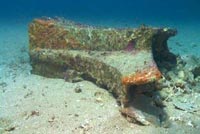 All that remains to mark the site of the final sea battle of the First Punic War between Rome and Carthage, around 241 BC, are the great bronze rams left behind after the rest of the sunken ships have rotten away in the warm waters of the Mediterranean Sea. The sea battle and the First Punic War, in general, were victories for Rome, marking its ascent, and Carthage’s decline as regional powers. Three rams have now been found near the island of Levanzo, west of Sicily.
All that remains to mark the site of the final sea battle of the First Punic War between Rome and Carthage, around 241 BC, are the great bronze rams left behind after the rest of the sunken ships have rotten away in the warm waters of the Mediterranean Sea. The sea battle and the First Punic War, in general, were victories for Rome, marking its ascent, and Carthage’s decline as regional powers. Three rams have now been found near the island of Levanzo, west of Sicily.
Ancient shipwreck points to site of major Roman battle
The remains of a sunken warship recently found in the Mediterranean Sea may confirm the site of a major ancient battle in which Rome trounced Carthage.
The shipwreck was found near the island of Levanzo, west of Sicily, which is where historical documents place the battle.
In the summer of 2010, Royal and his colleagues discovered a warship’s bronze ram – the sharp, prolonged tip of the ship’s bow that was used to slam into an enemy vessel. This tactic was heavily used in ancient naval battles and was thought to have played an important role in the Punic fights.
The ram is all that’s left of the warship; the rest, made of wood, apparently rotted away.
The new ram is the third such recent discovery near that site.
In 2008, the same team uncovered a beaten-up warship ram with bits of wood still attached, which the scientists were able to carbon-date to around the time of the end of the first Punic War.
Another ram that had been pulled out of the water by a fishing boat three years earlier in the same area bore an inscription dating it to the same time period.
This third ram, Royal said, is almost identical in shape and size to the one found in 2008.
